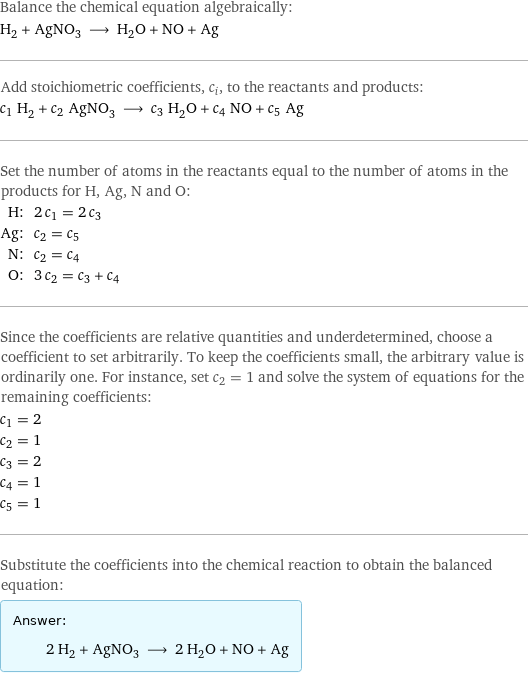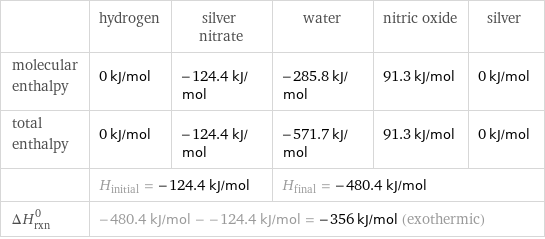Input interpretation

H_2 hydrogen + AgNO_3 silver nitrate ⟶ H_2O water + NO nitric oxide + Ag silver
Balanced equation

Balance the chemical equation algebraically: H_2 + AgNO_3 ⟶ H_2O + NO + Ag Add stoichiometric coefficients, c_i, to the reactants and products: c_1 H_2 + c_2 AgNO_3 ⟶ c_3 H_2O + c_4 NO + c_5 Ag Set the number of atoms in the reactants equal to the number of atoms in the products for H, Ag, N and O: H: | 2 c_1 = 2 c_3 Ag: | c_2 = c_5 N: | c_2 = c_4 O: | 3 c_2 = c_3 + c_4 Since the coefficients are relative quantities and underdetermined, choose a coefficient to set arbitrarily. To keep the coefficients small, the arbitrary value is ordinarily one. For instance, set c_2 = 1 and solve the system of equations for the remaining coefficients: c_1 = 2 c_2 = 1 c_3 = 2 c_4 = 1 c_5 = 1 Substitute the coefficients into the chemical reaction to obtain the balanced equation: Answer: | | 2 H_2 + AgNO_3 ⟶ 2 H_2O + NO + Ag
Structures

+ ⟶ + +
Names

hydrogen + silver nitrate ⟶ water + nitric oxide + silver
Reaction thermodynamics
Enthalpy

| hydrogen | silver nitrate | water | nitric oxide | silver molecular enthalpy | 0 kJ/mol | -124.4 kJ/mol | -285.8 kJ/mol | 91.3 kJ/mol | 0 kJ/mol total enthalpy | 0 kJ/mol | -124.4 kJ/mol | -571.7 kJ/mol | 91.3 kJ/mol | 0 kJ/mol | H_initial = -124.4 kJ/mol | | H_final = -480.4 kJ/mol | | ΔH_rxn^0 | -480.4 kJ/mol - -124.4 kJ/mol = -356 kJ/mol (exothermic) | | | |
Entropy

| hydrogen | silver nitrate | water | nitric oxide | silver molecular entropy | 115 J/(mol K) | 140.9 J/(mol K) | 69.91 J/(mol K) | 211 J/(mol K) | 42.6 J/(mol K) total entropy | 230 J/(mol K) | 140.9 J/(mol K) | 139.8 J/(mol K) | 211 J/(mol K) | 42.6 J/(mol K) | S_initial = 370.9 J/(mol K) | | S_final = 393.4 J/(mol K) | | ΔS_rxn^0 | 393.4 J/(mol K) - 370.9 J/(mol K) = 22.52 J/(mol K) (endoentropic) | | | |
Equilibrium constant
![Construct the equilibrium constant, K, expression for: H_2 + AgNO_3 ⟶ H_2O + NO + Ag Plan: • Balance the chemical equation. • Determine the stoichiometric numbers. • Assemble the activity expression for each chemical species. • Use the activity expressions to build the equilibrium constant expression. Write the balanced chemical equation: 2 H_2 + AgNO_3 ⟶ 2 H_2O + NO + Ag Assign stoichiometric numbers, ν_i, using the stoichiometric coefficients, c_i, from the balanced chemical equation in the following manner: ν_i = -c_i for reactants and ν_i = c_i for products: chemical species | c_i | ν_i H_2 | 2 | -2 AgNO_3 | 1 | -1 H_2O | 2 | 2 NO | 1 | 1 Ag | 1 | 1 Assemble the activity expressions accounting for the state of matter and ν_i: chemical species | c_i | ν_i | activity expression H_2 | 2 | -2 | ([H2])^(-2) AgNO_3 | 1 | -1 | ([AgNO3])^(-1) H_2O | 2 | 2 | ([H2O])^2 NO | 1 | 1 | [NO] Ag | 1 | 1 | [Ag] The equilibrium constant symbol in the concentration basis is: K_c Mulitply the activity expressions to arrive at the K_c expression: Answer: | | K_c = ([H2])^(-2) ([AgNO3])^(-1) ([H2O])^2 [NO] [Ag] = (([H2O])^2 [NO] [Ag])/(([H2])^2 [AgNO3])](../image_source/961a9dffba149a98020bea74519ade85.png)
Construct the equilibrium constant, K, expression for: H_2 + AgNO_3 ⟶ H_2O + NO + Ag Plan: • Balance the chemical equation. • Determine the stoichiometric numbers. • Assemble the activity expression for each chemical species. • Use the activity expressions to build the equilibrium constant expression. Write the balanced chemical equation: 2 H_2 + AgNO_3 ⟶ 2 H_2O + NO + Ag Assign stoichiometric numbers, ν_i, using the stoichiometric coefficients, c_i, from the balanced chemical equation in the following manner: ν_i = -c_i for reactants and ν_i = c_i for products: chemical species | c_i | ν_i H_2 | 2 | -2 AgNO_3 | 1 | -1 H_2O | 2 | 2 NO | 1 | 1 Ag | 1 | 1 Assemble the activity expressions accounting for the state of matter and ν_i: chemical species | c_i | ν_i | activity expression H_2 | 2 | -2 | ([H2])^(-2) AgNO_3 | 1 | -1 | ([AgNO3])^(-1) H_2O | 2 | 2 | ([H2O])^2 NO | 1 | 1 | [NO] Ag | 1 | 1 | [Ag] The equilibrium constant symbol in the concentration basis is: K_c Mulitply the activity expressions to arrive at the K_c expression: Answer: | | K_c = ([H2])^(-2) ([AgNO3])^(-1) ([H2O])^2 [NO] [Ag] = (([H2O])^2 [NO] [Ag])/(([H2])^2 [AgNO3])
Rate of reaction
![Construct the rate of reaction expression for: H_2 + AgNO_3 ⟶ H_2O + NO + Ag Plan: • Balance the chemical equation. • Determine the stoichiometric numbers. • Assemble the rate term for each chemical species. • Write the rate of reaction expression. Write the balanced chemical equation: 2 H_2 + AgNO_3 ⟶ 2 H_2O + NO + Ag Assign stoichiometric numbers, ν_i, using the stoichiometric coefficients, c_i, from the balanced chemical equation in the following manner: ν_i = -c_i for reactants and ν_i = c_i for products: chemical species | c_i | ν_i H_2 | 2 | -2 AgNO_3 | 1 | -1 H_2O | 2 | 2 NO | 1 | 1 Ag | 1 | 1 The rate term for each chemical species, B_i, is 1/ν_i(Δ[B_i])/(Δt) where [B_i] is the amount concentration and t is time: chemical species | c_i | ν_i | rate term H_2 | 2 | -2 | -1/2 (Δ[H2])/(Δt) AgNO_3 | 1 | -1 | -(Δ[AgNO3])/(Δt) H_2O | 2 | 2 | 1/2 (Δ[H2O])/(Δt) NO | 1 | 1 | (Δ[NO])/(Δt) Ag | 1 | 1 | (Δ[Ag])/(Δt) (for infinitesimal rate of change, replace Δ with d) Set the rate terms equal to each other to arrive at the rate expression: Answer: | | rate = -1/2 (Δ[H2])/(Δt) = -(Δ[AgNO3])/(Δt) = 1/2 (Δ[H2O])/(Δt) = (Δ[NO])/(Δt) = (Δ[Ag])/(Δt) (assuming constant volume and no accumulation of intermediates or side products)](../image_source/549ab4d3c6236fbe409487c365c2a965.png)
Construct the rate of reaction expression for: H_2 + AgNO_3 ⟶ H_2O + NO + Ag Plan: • Balance the chemical equation. • Determine the stoichiometric numbers. • Assemble the rate term for each chemical species. • Write the rate of reaction expression. Write the balanced chemical equation: 2 H_2 + AgNO_3 ⟶ 2 H_2O + NO + Ag Assign stoichiometric numbers, ν_i, using the stoichiometric coefficients, c_i, from the balanced chemical equation in the following manner: ν_i = -c_i for reactants and ν_i = c_i for products: chemical species | c_i | ν_i H_2 | 2 | -2 AgNO_3 | 1 | -1 H_2O | 2 | 2 NO | 1 | 1 Ag | 1 | 1 The rate term for each chemical species, B_i, is 1/ν_i(Δ[B_i])/(Δt) where [B_i] is the amount concentration and t is time: chemical species | c_i | ν_i | rate term H_2 | 2 | -2 | -1/2 (Δ[H2])/(Δt) AgNO_3 | 1 | -1 | -(Δ[AgNO3])/(Δt) H_2O | 2 | 2 | 1/2 (Δ[H2O])/(Δt) NO | 1 | 1 | (Δ[NO])/(Δt) Ag | 1 | 1 | (Δ[Ag])/(Δt) (for infinitesimal rate of change, replace Δ with d) Set the rate terms equal to each other to arrive at the rate expression: Answer: | | rate = -1/2 (Δ[H2])/(Δt) = -(Δ[AgNO3])/(Δt) = 1/2 (Δ[H2O])/(Δt) = (Δ[NO])/(Δt) = (Δ[Ag])/(Δt) (assuming constant volume and no accumulation of intermediates or side products)
Chemical names and formulas

| hydrogen | silver nitrate | water | nitric oxide | silver formula | H_2 | AgNO_3 | H_2O | NO | Ag name | hydrogen | silver nitrate | water | nitric oxide | silver IUPAC name | molecular hydrogen | silver nitrate | water | nitric oxide | silver